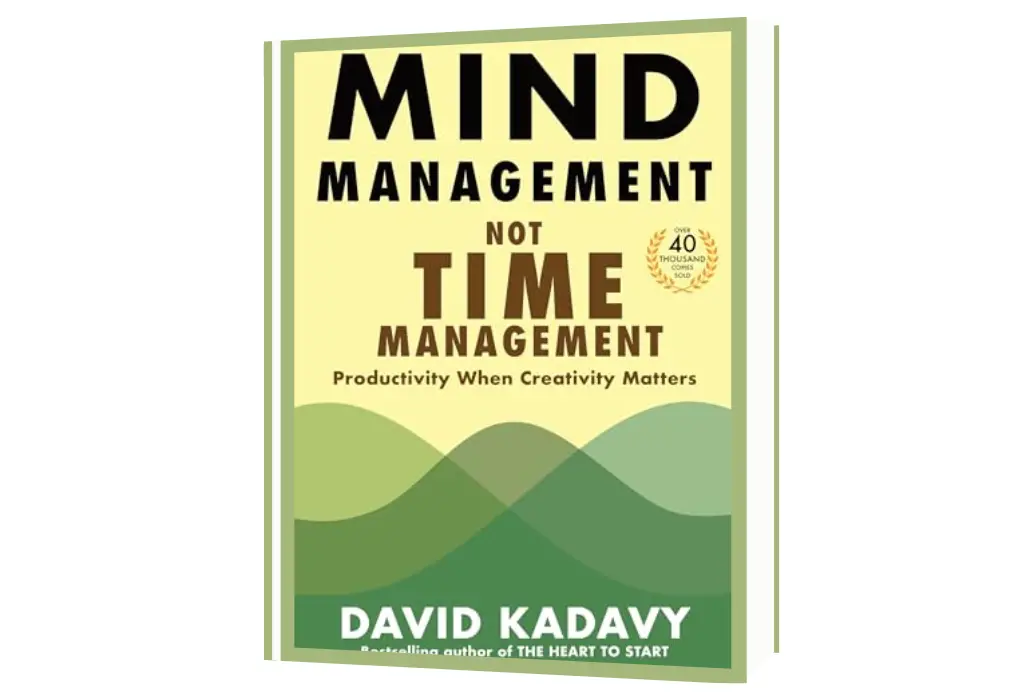Mind Management, Not Time Management: Productivity When Creativity Matters** by David Kadavy
Summary
David Kadavy’s “Mind Management, Not Time Management” offers a revolutionary approach to productivity by emphasizing the management of one’s mind over the conventional concept of time management. The book suggests that productivity, especially in creative endeavors, is less about meticulously planning time and more about understanding and optimizing one’s mental states and energy levels.
Introduction: The Problem with Time Management
Kadavy begins by highlighting the shortcomings of traditional time management techniques for creative work. He argues that creativity cannot be scheduled like routine tasks because it relies on unpredictable insights and mental energy. Time management frameworks often fail to account for the fluctuating nature of creative productivity.
Part 1: Understanding Creativity and Productivity
Chapter 1: The Nature of Creativity
Creativity is not a linear process. Kadavy explains that creative work involves various mental states, including periods of inspiration, incubation, and execution. Recognizing these states is crucial for effective mind management.
Chapter 2: The Myth of Efficiency
Kadavy challenges the idea that maximizing efficiency leads to higher productivity. For creative tasks, quality often trumps quantity, and this quality emerges from deep focus and inspiration, not from strict schedules.
Part 2: The Framework of Mind Management
Chapter 3: Aligning Work with Mental States
Kadavy introduces the concept of aligning tasks with appropriate mental states. For instance, ideation requires a different mental state than editing or executing. He suggests identifying peak mental states and matching them with the right tasks.
Chapter 4: Energy and Focus Cycles
Understanding one’s energy and focus cycles is key to mind management. Kadavy advises tracking periods of high and low energy to optimize task scheduling. High-energy periods are best for challenging creative work, while low-energy periods can be used for routine tasks.
Chapter 5: The Power of Rituals
Rituals help transition between different mental states. Kadavy discusses how establishing pre-work rituals can prepare the mind for creative tasks, while post-work rituals can aid in unwinding and incubation.
Part 3: Strategies for Mind Management
Chapter 6: Deep Work and Flow
Kadavy draws on Cal Newport’s concept of deep work and Mihaly Csikszentmihalyi’s flow theory. He explains how to create environments conducive to deep work, minimizing distractions and maximizing immersion in tasks.
Chapter 7: Incubation and Downtime
Creativity often happens subconsciously during downtime. Kadavy emphasizes the importance of breaks and leisure activities that allow the subconscious mind to process information and generate insights.
Chapter 8: Mindfulness and Meditation
Mindfulness practices, such as meditation, can enhance mental clarity and focus. Kadavy suggests incorporating mindfulness into daily routines to improve overall cognitive function and creativity.
Part 4: Applying Mind Management
Chapter 9: Planning for Creativity
Instead of rigid schedules, Kadavy advocates for flexible planning that prioritizes creative tasks during peak mental states. He offers practical tips for creating a dynamic, adaptable plan that accommodates the unpredictable nature of creativity.
Chapter 10: Tools and Techniques
Kadavy reviews various tools and techniques to support mind management, including time-blocking (with flexibility), journaling, and digital tools for tracking mental states and productivity patterns.
Chapter 11: The Role of Environment
The physical environment can significantly impact mental states. Kadavy advises designing workspaces that inspire creativity and minimize distractions, tailoring the environment to personal preferences and needs.
Part 5: Sustaining Mind Management
Chapter 12: Building Resilience
Resilience is essential for maintaining productivity in the long term. Kadavy discusses strategies for managing stress, maintaining motivation, and bouncing back from creative blocks or setbacks.
Chapter 13: Continuous Improvement
Mind management is an ongoing process of learning and adaptation. Kadavy encourages regular reflection on what works and what doesn’t, promoting a mindset of continuous improvement and experimentation.
Conclusion: Embracing a New Productivity Paradigm
Kadavy concludes by reiterating that mind management is a more effective approach for creative productivity than traditional time management. By understanding and optimizing mental states, energy levels, and work environments, individuals can achieve higher levels of creativity and productivity.
Key Takeaways
1. Creativity is Non-Linear: Recognize the fluctuating nature of creative work and adapt your productivity strategies accordingly.
2. Align Tasks with Mental States: Match tasks with appropriate mental states to optimize productivity and creativity.
3. Track Energy Cycles: Understand your energy patterns and plan your work around periods of high and low energy.
4. Incorporate Rituals: Use rituals to transition between different mental states and to signal the start and end of work periods.
5. Prioritize Deep Work: Create environments and schedules that facilitate deep work and flow, minimizing distractions.
6. Value Downtime: Embrace breaks and leisure activities as essential components of the creative process.
7. Practice Mindfulness: Incorporate mindfulness practices to enhance focus, clarity, and cognitive function.
8. Flexible Planning: Develop adaptable plans that prioritize creative tasks during peak mental states rather than adhering to rigid schedules.
9. Optimize Environment: Design workspaces that inspire creativity and support productive mental states.
10. Build Resilience: Develop strategies for managing stress and maintaining motivation to sustain long-term productivity.
11. Continuous Improvement: Regularly reflect on and adjust your productivity strategies to find what works best for you.
By shifting the focus from managing time to managing the mind, Kadavy provides a fresh perspective on productivity that aligns more closely with the needs of creative professionals. His insights offer a practical and adaptable framework for achieving sustained creative output and overall well-being.







